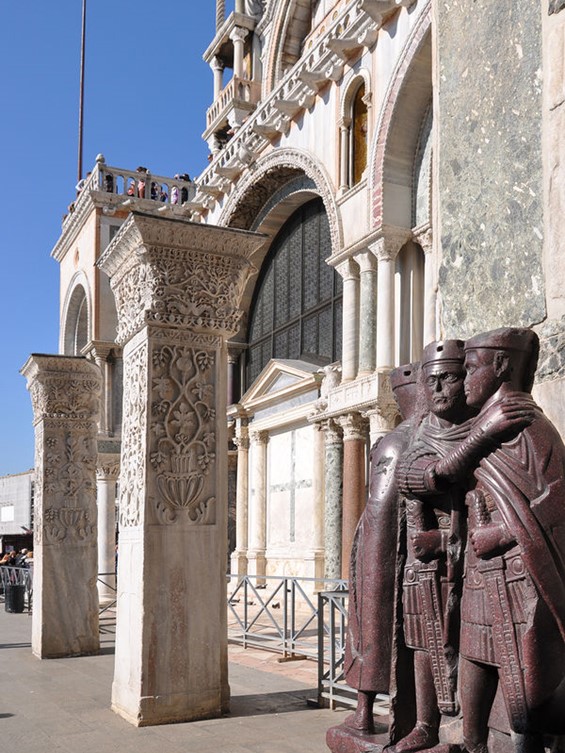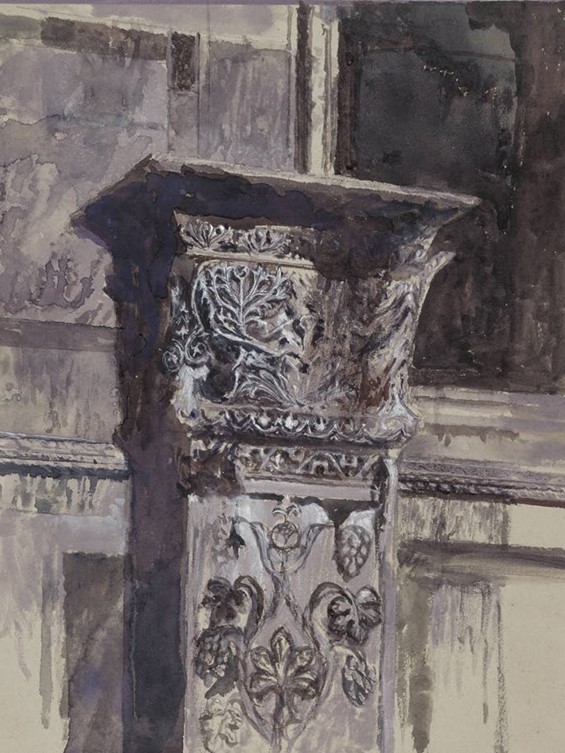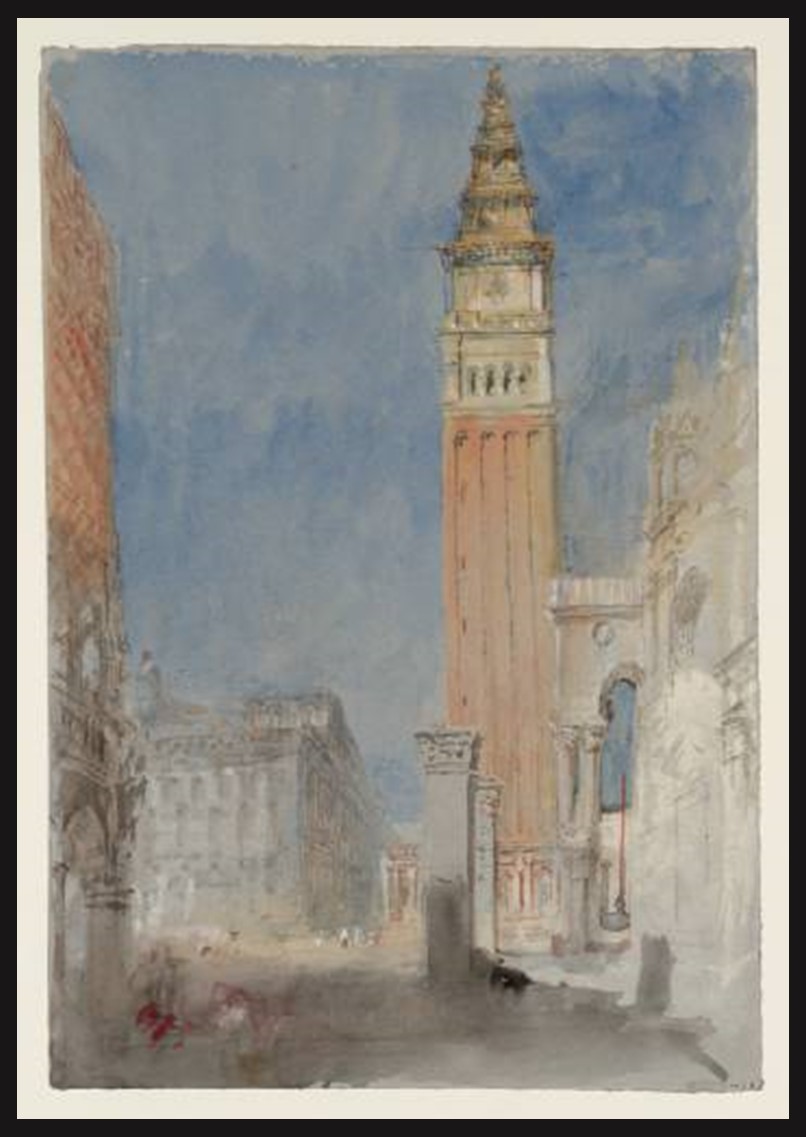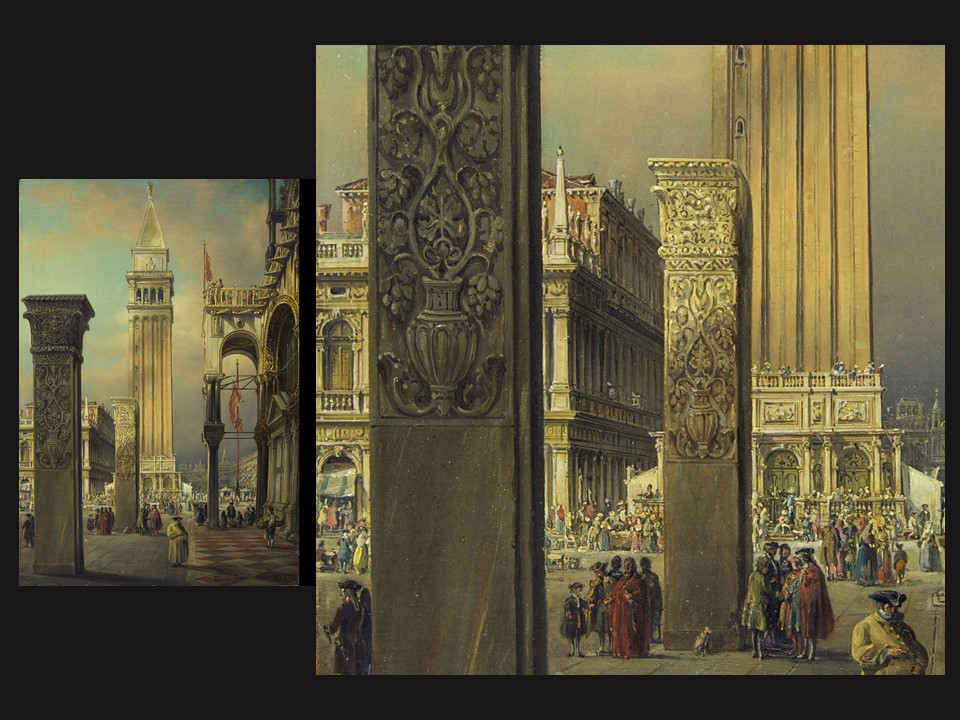
Pilastri Acritani (piers from the 6th century Church of the Holy Martyr Polyeuktos in Constantinople) and the Tetrarchs (from Constantinople, c. 305, porphyry) on the South-West side of the Basilica of San Marco, in Venice https://venicewiki.org/wiki/Colonne_d%27Acri
“In December 1826, the German merchant and art collector Johannes David Weber (1773–1847) wrote to the younger Venetian jurist and local antiquarian Emanuel Antonio Cicogna (1789–1869) about two stone pillars on the south side of the Church of San Marco in Venice… With Weber’s letter begins the modern study of what came to be known as the PilastrιAcritni, the pillars of Acre, because Weber and many before him regarded them as trophies of the Venetian defeat of the Genoese at Acre in the mid-thirteenth century. Decorated with vine ornament, crosses, and Greek monograms, the piers are simple, if imposing, monoliths that have few overt clues to their origin; hence, the problem that Weber’s letter sought to solve. In 1960, the Venetian historiographic tradition that Weber represents was overturned by the discovery of the sixth-century Church of Hagios Polyeuktos in Istanbul. Its subsequent excavation proved that the piers came from this site, most likely in the aftermath of the Venetian-led Fourth Crusade that sacked Constantinople in 1204…” A straightforward introduction by Robert Nelson, I humbly borrow, for my new POST, Pilastri Acritani and European 19th century Art. https://www.academia.edu/3585135/_The_History_of_Legends_and_the_Legends_of_History_The_Pilastri_Acritani_in_Venice_in_H_Maguire_and_R_Nelson_eds_San_Marco_Byzantium_and_the_Myths_of_Venice_Washington_D_C_Dumbarton_Oaks_Research_Library_and_Collection_63_90

St. Jean d’Acre pillar on the southern side of the Basilica di San Marco, 1879, British Museum, London https://www.apollo-magazine.com/john-ruskins-visions-of-venice/
“The Pilastri Acritani (‘Pillars of Acre’) are two elaborately decorated pillars,” writes David Hendrix in Byzantine Legacy “near the southern side of the Basilica of San Marco in Venice. The pillars are among the many spoils looted in the sack of Constantinople in 1204. They were also considered by John Ruskin to be the two most noble pillars in Venice. As their name suggests, they were long regarded as trophies of the Venetian defeat of the Genoese in Acre. In 1960, excavations in Istanbul proved that they originated from the Church of Hagios Polyeuktos. Decorated with vine ornament, crosses, and Greek monograms, the pillars share features of other architectural remains found in the excavation which can now be found at the Istanbul Archaeological Museums. Most likely they were brought back to Venice after the sack of Constantinople in 1204. The area around the Church of Hagios Polyeuktos became of the Venetian sector of Constantinople, which was centered at the nearby Pantokrator Monastery…” https://www.thebyzantinelegacy.com/pilastri-acritani
I enjoyed reading… “The History of Legends and the Legends of History: The ‘Pilastri Acritani’ in Venice,” in H. Maguire and R. Nelson, eds., San Marco, Byzantium and the Myths of Venice, Washington, D.C.: Dumbarton Oaks Research Library and Collection, 63-90 and “Pilastri Acritani” in Byzantine Legacy. Both articles/presentations intrigued my curiosity to find 19th-century European artworks inspired by the amazing Constantinopolian treasures in the Basilica of San Marco in Venice. I searched the Internet and here is what I discovered… I am sure there is more, maybe another time another day…
For a PowerPoint on the Pilastri Acritani and European 19th century Art, please… Check HERE!

The Campanile and Piazza of San Marco (St Mark’s Square), Venice, with the Pilastri Acritani beside the Basilica, from the Porta della Carta of the Palazzo Ducale (Doge’s Palace), 1840, Gouache, pencil and watercolour on grey wove paper, 282 x 191 mm, TATE, London https://www.tate.org.uk/art/research-publications/jmw-turner/joseph-mallord-william-turner-the-campanile-and-piazza-of-san-marco-st-marks-square-venice-r1197042

Venice, St. Mark’s Square with the Acritani Pillars, oil on canvas, 65,5 x 45,5 cm, Salamon Gallery, Milan https://www.salamongallery.com/dipinti_opera.php?codice=66